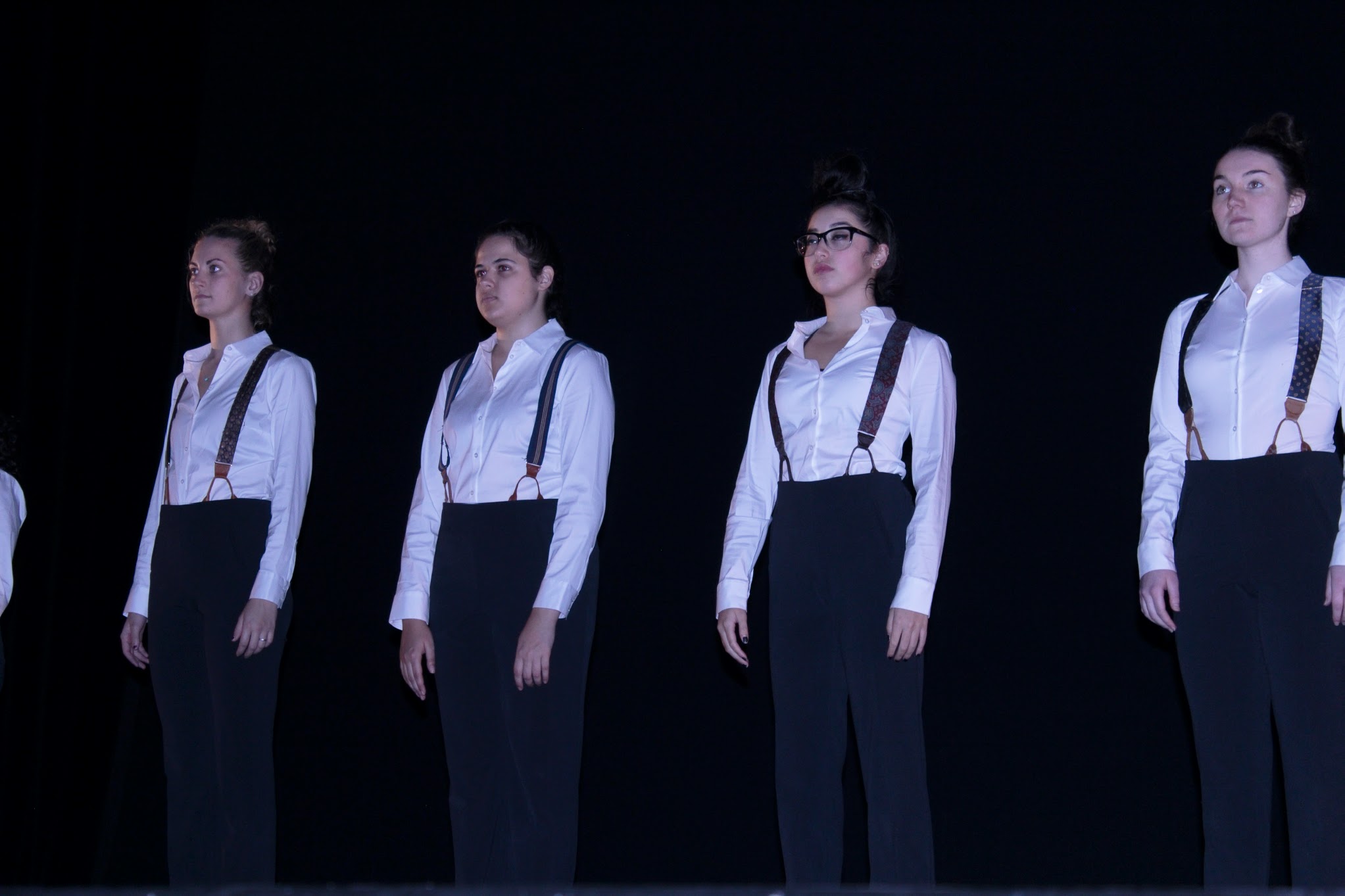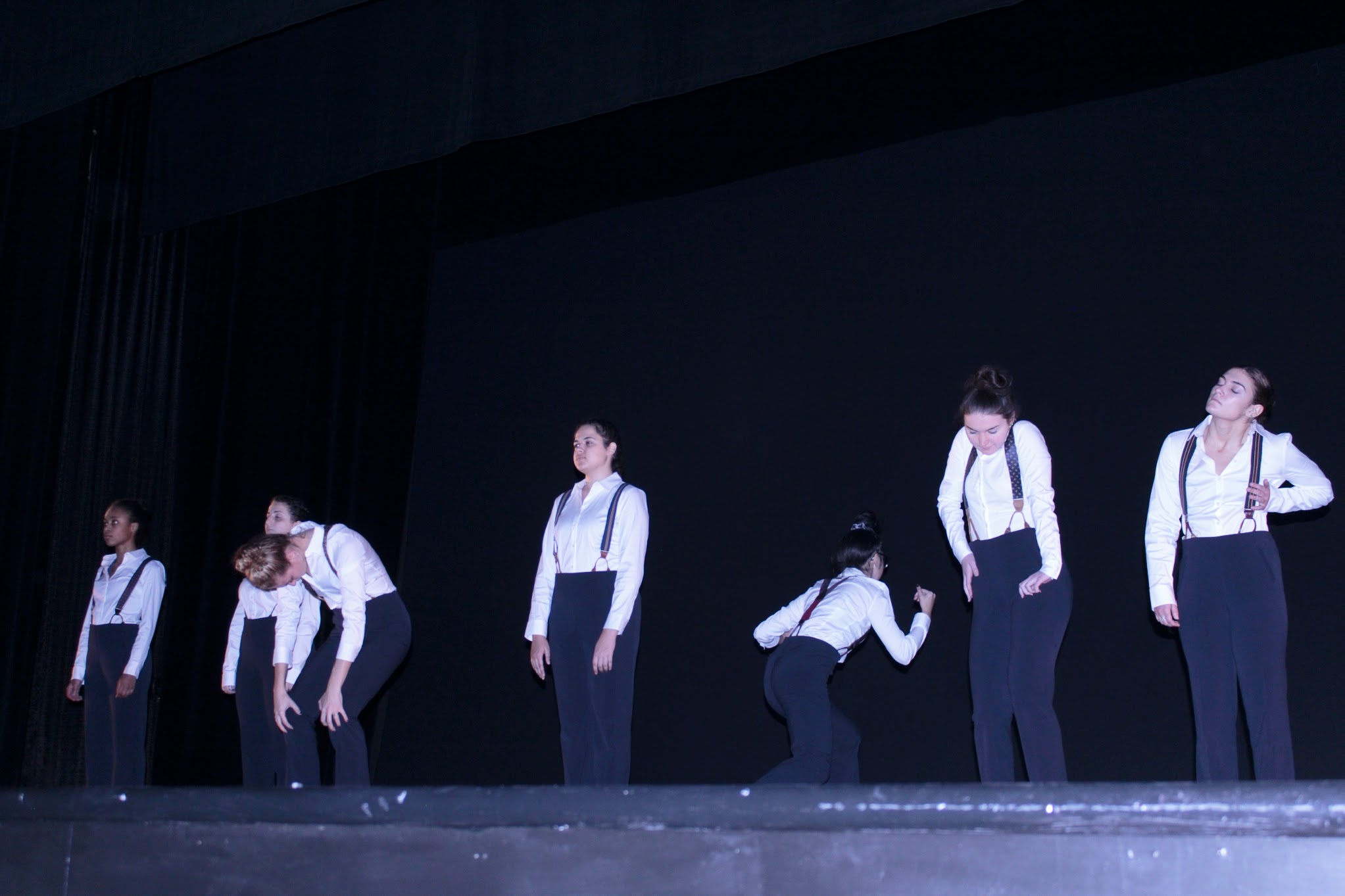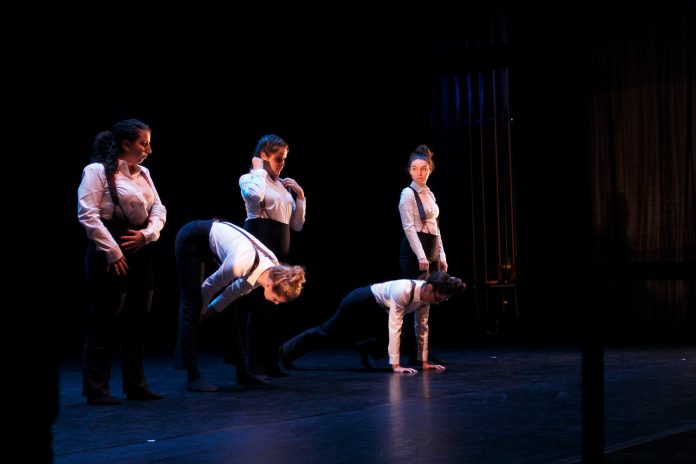The lights are dim in Baker Theatre. Though many performances are showcased here over the course of the semester, this one feels … different. As audience members slowly shuffle into their seats, finally finding the one that was meant for them and settling in, they’re not waiting for the curtain to rise on a set, on a scene ready to begin. They’re waiting for changeable, malleable, moving stories; moments in time preserved by bodies in motion.
As the lights fade away, a voice fades in. There is no beat, no music, no notes except for the cadence of her speech. If you haven’t analyzed the show’s program, you won’t know who she is—yet her words compel the women on stage to thrust shaking hands into the air, to crumple themselves and re-form only to repeat the cycle again. As the woman’s voice makes a passing statement about being First Lady, some audience members gasp, one even whispering, “I was wondering who that was!” Michelle Obama’s voice continues to invite these women to move, to try and try again as they are knocked down by unseen figures and, ultimately, to stretch out their hands and help the others get back up again. Piano music replaces Obama’s words as the women dance as parts of a whole, lining up and performing certain actions like a wave. When the lights fade away, the audience erupts in applause.
This is Emily Ancona ‘18’s “And Nothing Less,” the first piece in Fall 2017’s iteration of the annual dance mainstage Moving Stories. One of eight breathtaking pieces over the two-act show, Ancona’s work immediately makes the audience aware of a central theme of the night: sisterhood and the stories of women.

“I had been reading a lot of feminist literature over the past summer and I think that gave me the foundation I needed on which to build this piece,” Ancona said. “I got a lot of inspiration from my own female friends and the way communities of women seem to form in support during crises. My dancers were also a huge inspiration to me. I like to work collaboratively, so the dance is not only mine, but theirs as well and I think the subject of the piece meant as much to them as it did to me.”
The piece itself embodies the passion and togetherness that went into its creation, according to Ancona.
“It has themes of tension and release, partnering work, and stark floor patterns. It explores the idea of women being stuck in a mold and gradually being able to break out of it and form connections with other women,” said Ancona. “This community of women [works] together to explore their freedom and support each other in times of crisis. My dancers all play versions of themselves; they contributed choreography based on experiences they’ve had as women and explored their journeys and their characters in the piece through writing.”
Several other choreographers also utilized this tactic in order to make certain that their dancers were heavily involved in the process of creating the final work. Dancer Jess Afflerbach ’19 recounts how choreographer Caitlyn Kraemer ’19 incorporated the individuality and ideas of her dancers into her dreamy, autumnal piece, “Fields Lie Fallow.”
“Having the opportunity to be in a piece and work alongside one of my closest friends was an absolute gift,” Afflerbach said. “Cait is incredibly smart when it comes to choreographing and she is also very understanding of the limitations of every dancers’ body and the way we feel comfortable when we move. The work was centered around specific moments in each of our lives that we wrote about in the very first rehearsal, and being able to dance about the feelings and thoughts I know so well, from the moment in life that I chose, was really fulfilling.”
This sense of collaboration was also vital to the creation of Lauren McGinty ‘18’s piece, “Unmistakable, She.” Like the other choreographers, McGinty was chosen from a group of applicants with experience in the Advanced Dance Composition course after answering questions about her vision for the piece and presenting a dance sample to a panel of faculty members. McGinty knew she wanted to pursue a narrative that included the experiences of the dancers she would soon be partnered with for months of work.
“I was originally inspired by all of the amazing women in my life and how they relate to me in such different ways,” said McGinty. “Because they all embody their womanhood in their own unique way, I wanted to explore my dancers’ womanhood and what it means for them. However, throughout the process, my piece became less about defining or explaining womanhood and evolved into [an] individual celebration of each dancer inspired by their womanhood. From sitting down with my dancers and learning about them on [a] personal level to [seeing] them sharing this information with the audience through movement was such an uplifting experience for me.”
And how uplifting it was for everyone who saw it—though the rest of the pieces in the show embodied more subdued and pensive narratives, McGinty’s work took shape with each dancer clothed in bright pink or purple, their flowy shirts and pants ready to move with any burst of energy. The entire dance seemed to be a celebration. The dancers grinned and laughed and made eye contact before performing certain movements, allowing the audience in on some inside joke that couldn’t help but make us smile too.
If Ancona’s work showcased the struggles and successes of a sisterhood attempting to gain traction, this one was its perfect epilogue: a joyful, triumphant, carefree collective of women who are able to express themselves freely and fully control their destinies. In the piece’s last seconds, a single dancer closes the show with a sassy snap that brings down the lights and turns off the music, causing the audience to laugh along with her. It is this kind of feedback, McGinty insists, that makes dance shows so vital to the world of performance.

“These original works are so important to share with audiences because they offer a closer look at humanity through a purely physical mode of communication which leaves audiences with their own visceral reaction that only dance is capable of creating,” McGinty said. “This visceral reaction is an honest response which can allow audiences to reflect on themselves either directly or indirectly in such a way that they may not even understand is happening in the moment.”
Sitting in Baker, listening to the gasps and whispers of the audience around me as a dancer climbs up an aerial silk, as in Nicollette Amico ‘18’s “Distant Pieces in Dark Places,” or plays rapid-fire mirror games with their partner, as in Marissa Finkelstein ‘18’s “Moments Eclipsed,” I can’t help but conclude that McGinty is right. There is something special about dance, that art form where words speak through pointed or straight toes and arching or contorted limbs.
There is something that taps into our universal ability to understand, to make our own stories from the movements—to connect.
Brooke is a senior double majoring in English and Media & Communication. She's passionate about french toast, Kate Bishop, Steven Universe and the ocean coasts of Ireland. On campus, she is a Writing Tutor, Orientation Leader and member of the Girls Next Door, Muhlenberg's all-lady a capella group. She could not be more excited to serve as your Editor-In-Chief this year!






















